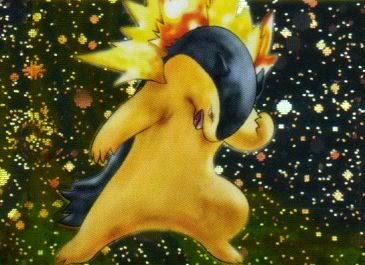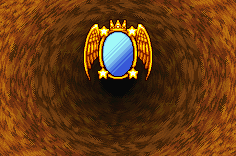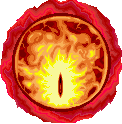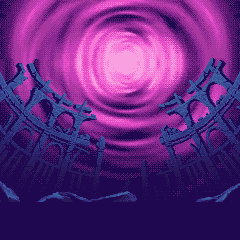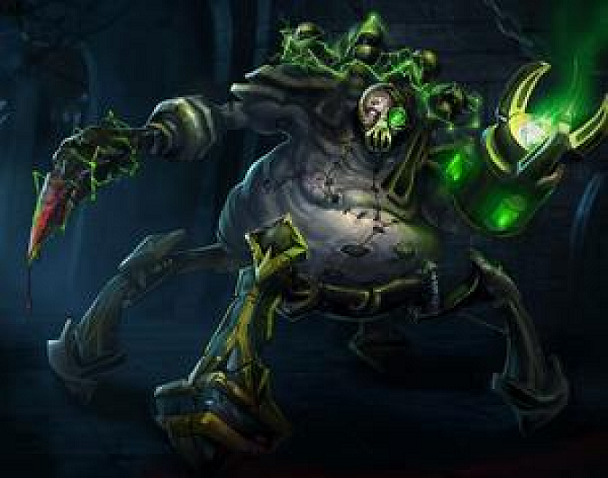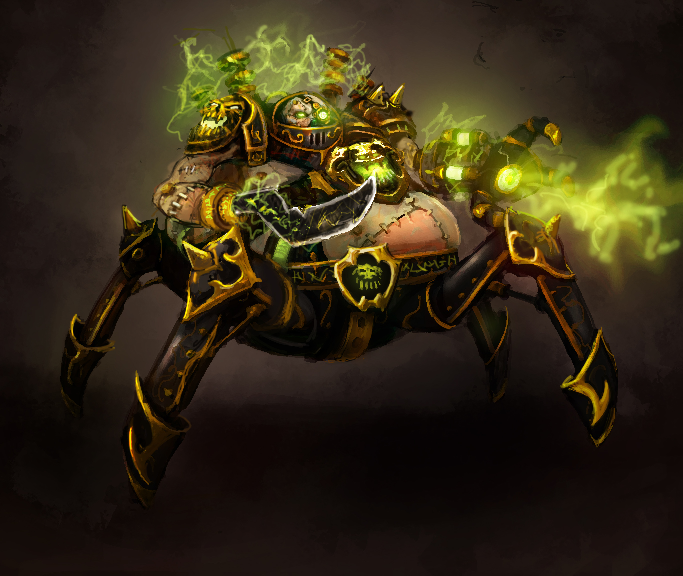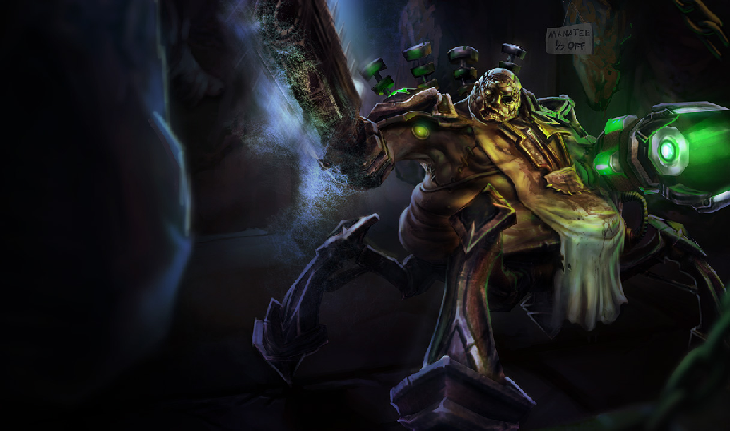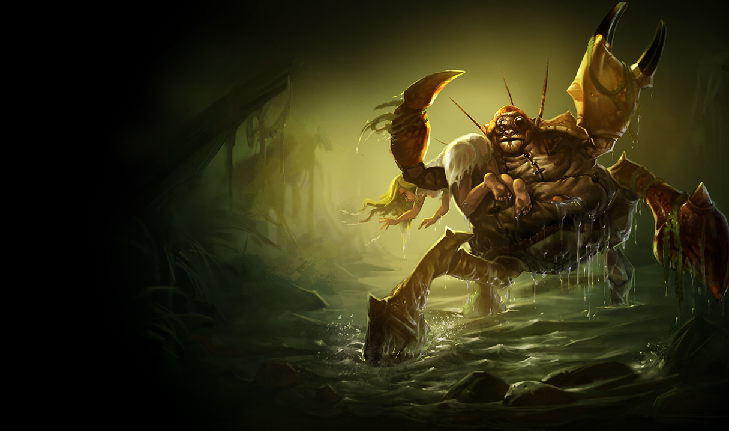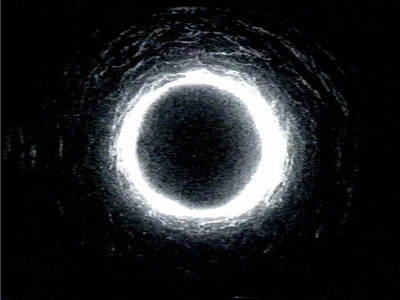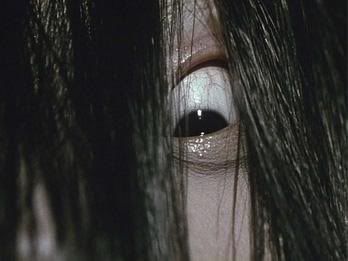This is my first post in the thread for a... long time. It seems a foregone conclusion now, but I'll be retiring the Smady Ratings and Sundae Summary until MYM9 – where they will make a return. The story on the recent inactivity simply boils down to a lack of motivation; what with my re-instatement into leadership, I've been given a second wind in trying to catch up, but to go back and rate as well as comment everything I missed is simply not possible. I will be reading them all [perhaps not as in-depth as I normally would, again in the interest of time],
though, so as with my audio reviews back in the day, just give me a buzz if you want me to comment a particular set, and I'll add it to this next bunch – obviously telling the requester when I do. Now it's way too late to do that, I'm afraid.
This is simply a lot of comments I had been working on for a long time, over several months. It's not that impressive, yet I felt obliged to post it seeing as we're coming onto the end of this contest. I know, for example, Nate has been waiting for this Haunter comment for a while... these comments obviously lack any sort of rating attachment.
[collapse=Lots and lots of STUFF]And my biggest break from commenting was here since Make Your Move 7 – oh joy, non-sarcastically in fact, as I have the pleasure of giving my take on
Dionysus, surely one of Kupa’s best movesets in his long and envious career. It’s not so much that this moveset does anything particularly new, but that it captivates with a few golden nuggets and runs away with it by nailing them down with a perfectly simple playstyle.
As always, got to get onto the things completely unrelated to the moveset; that’s how I roll, in fact. So Dionysus is an ancient Greek God, like how Hades [though a complete spit in the face to the mythological Hades] was inspired through similar literature. Obviously, the comparison is hedgy at best; with the greatest comparison I can draw being that poor Odysseus a year-or-so ago. Drawing upon such a unique base is hardly unaccustomed to you, after Zinger, Stanley, Bleak and those two Donkey Kong cartoon characters in that joint with Warlord, but it only becomes more impressive over time that you’re able to find these figurative goldmines of a resource. There’s just no one else I can see this moveset working for other than this obscure character, while working perfectly fine in Smash – which is far more difficult to produce than write about.
Your writing style and organisation are perhaps the worse side of the penny in regard to your steadfastness – it’s never to the levels of total depravity, but there are several sections that lost me in terms of following what’s being expressed. Mostly, this is surrounding the areas in which you talk about manipulating the vineyard; its current status and interactions relevant to this, how it affects characters already caught by it, how it is itself affected. Notably, I found myself, several times, confused over how a move worked. I suppose I could complain about the organisation more, if not for the otherwise adequate and well-descript writing style of yours, always with the intriguing and insightful quips that nurses interest while reading, at the same time bestowing factoids upon the reader; perhaps you’re simply running away with this splendid idea?
Speaking of ideas, the way you’ve really simplified down several of your old mechanic ideas into something more intuitive and perfectly fitting for this character is downright impressive. The grab and health-reliant mechanics from Hades are back, slotting in rather nicely here – the grab because of its extending, the health thing being the grapes. You use them in a refreshing way, though, by linking in with that great vineyard mechanic. It almost makes him too much of a monster – the opponent can never escape, permanently being forced to approach by both the grapes and that sinister throw which has to be one of the most powerful I’ve ever seen, without being hilariously overpowered. What’s a little disappointing is that you use other moves like the up smash to similarly break smash conventions, lessening the impact of the grab.
That’s generally where I would say I dislike this moveset – in that its playstyle doesn’t really come off as anything particularly suited to Dionysus, despite the effort you went to in order to produce a capable moveset for such an anonymity. He forces a constant approach – at close range his tilts are all simply to stall or stun, while the smashes are generally pretty random; inputs like with the healing grapes, while an interesting take on an old idea, seem a little unimaginative here, while the gas seems to serve the same purpose as all his tilts and a few of the airs similarly seem unsuited. Very few of these move tie into anything but the vineyard, relying entirely on the set up of this move.
The lack of detail on how to set up is also rather unnerving, with the required three seconds seemingly relying on the player’s ability to hold off enemy attacks with moves suited for when you already have it up. The fact you have to do this in every match also occurs to me as somewhat of a grind, eventually leading to Dionysus becoming a tired character where few techniques to use his vineyard aren’t already well-known by every John and scrub, making half the challenge of playing him simply setting up. You don’t deny this in the moveset, or specifically the playstyle, but many of the tilts and airs really wouldn’t work well as a stall, with the required three seconds.
Despite my criticisms, I still feel it’s a very strong moveset. The way it works as a team moveset is similar to Nurse Joy, in drastically changing the main aim of the playstyle, while keeping intact the general message or flow of the moveset is again very remarkable. Many of the more situational moves become more useful with three other players on the field, though the set-up part in all of this is still a little hard to get by, as Dionysus is a complete anchor to any character not suited to protecting him. Really, though, it’s an interesting concept to combine a heavy set-up and reward character like this with any kind of approach-orientated or other sorts of set-up characters. Not to wander off-point, but I felt the match-ups were decent, while I did find the lack of doubles match-ups disturbing. Overall, an awesome effort and solely lacking the Zinger playstyle in being your best ever, but it does have numerous flaws.
Onto
Dunsparce, which is suffice to say not Koppa Kirby’s best in the slightest. From the get-go, you make the mistake of mapping very simple actions to inputs like the ‘taunt’ button, which could simply be accomplished by moving the analogue stick. This may seem nit-picky, but there’s so much superfluity throughout the set, it becomes a bore to read. That, and the blatant Pokémon influence in the form of Pokémon syndrome – rather than being inspired by an idea for a playstyle, or the character itself, liberties are taken in simply stealing moves and giving them any kind of attack properties whatsoever. It comes across as laziness.
Firstly, it is practically missing an up smash, with a very generic shared input. Likewise with the down and back air, which is a pairing I had never thought I’d see. It creates a Kat-like air of humour when reading the set, along with some of the equally bizarre figures like, ‘0.14 seconds,’ or, ‘0.03 seconds’ – at which point, the move is more-or-less instantaneous, right? Similarly, the odd numbers attached to many of the damage percents – ranging anywhere below ten, mainly ignoring that this kind of damage isn’t really worth differentiating to such a dramatic degree. The writing style is just super anal, but I’ll get back onto that later. Foremost here, there are big, obvious flaws that make it a challenge to even take Dunsparce seriously which could easily have been averted.
The big problem here is that there’s no conceited effort in trying to connect any of Dunsparce’s moves together, in any way that either emphasizes the personality of the character or how he plays in Pokémon. Sure, you take plenty of the moves he can theoretically perform, but you don’t do it with prejudice. In the end, this means that most moves end up feeling very disjointed, to the point that there is almost a theme of disjointedness. Where there are interesting ideas, such as with the slow dart or string shot, it’s not capitalised on and the moveset suffers for it.
As is the natures of a quickly-produced moveset, many traits of the project seem more than a little rushed; the language used seems to always go off on insignificant tangents of detail, there are mechanics thrown into moves that are more complimentary as literary filler than anything to do with the playstyle and that section is also somewhat lacking. This is due to the way you list out the moves and their interactions, leaving little in the way of a general summary, other than Dunsparce being a ‘non-defensive, peppering approaching’ character, which is, sadly, not very well illustrated throughout much of the rest of the moveset.
Really, I’m looking at my word count right now and just figuring out if this is long enough to substantiate Dunsparce over my shorter comments, but there’s little to say here because of the air of absence surrounding many attributes of the production. In all, it just isn’t a satisfying moveset and you take many a step backward from Burst Man… but obviously, it was a rushed moveset and you ‘saved’ one of the weeks from being completely dead. Alas, of what we have learned here: absolutely nothing.
Krystal and
Knuckles share so many common faults, niggles and generally fit so well together, it may as well be a multi-set project, especially considering they were posted so closely together and by a user I doubt we’ll see again. For a newcomer, the moves aren’t too bad – you’re missing some inputs, others are criminally under-detailed and there’s a blatant lack of thought put into anything to do with, like, playing as the character, but that’s what all newcomer movesets accomplish. If the user who created these is actually still in Make Your Move in any way and reading this comment, simply don’t be discouraged at how your movesets compare to all the rest, because it’s not a fair comparison.
[Admittedly, this is hardly a comment, but I’m not rating either of these due to the author being a newcomer and so many people have touched on them, it seems like I would be entirely repeating what others have said. There’s little else to comment on other than, yes, these are newcomer movesets and have blatant flaws that should be addressed.]
So after a terrible comment there, time to actually write one for the by now well-received Colonel Sanders; it’s a great newcomer moveset – and that’s all I’ll say about that, hopefully. I’ve already said enough about a person’s history or newness in past commentary in this very block, so it seems clinically hazardous to any reader of this big ole wall to then throw more and more of that in here. Without further ado, my thoughts on the Colonel are as follows.
The egg, chicken and drumstick mechanic is pretty interesting. The interactions between the egg – it being useable as a projectile, being crushable and causing tripping – are well thought out; make sense from both a lateral and thematic sense with Sanders. Similarly with the chicken, creating your own producer of the eggs is fairly interesting and makes perfect sense: difficult to express, but I feel this was really well-written in terms of detailing what a chicken actually does, but later on you start being a little too lenient with no damage percents or knockback. The drumsticks part, along with the ten-piece bucket, is where things start not quite going to plan, but it’s still solid. It seems like Sanders has a healing scheme similar to Dionysus’, but it’s not really described enough to really let us know (Junahu must love this moveset).
The writing style deserves its own part in this commentary, truly. There’s something to be said about your modest way of expressing attributes through the five-star rating system – possibly the wisest system one can choose for ratings, indeed – but at the same time, you miss out on key details like specific percents in which one can hope to knock out opponents and how much damage a move does or the time taken to do it. This would all be solved if, like Junahu, you simply expressed as some point a kind of ‘key’ to this map of attributes, so one-star would actually mean something. Otherwise, it’s all self-referential and thus rather alien to most of us. I can’t really fault you for it, though, considering it’s a unique take on things and there are several bigger nagging feelings I have about the moveset’s general lack of professionalism. Read: first paragraph for that one.
If I have any real problem with the moveset, it’s those rather generic inputs. Not to say they aren’t fitting for the Colonel, but there’s not an ounce of flow between any of them – he randomly pokes with his cane, throws a bucket, etcetera, etcetera and it doesn’t really fit in with his pretty distinctive mechanic, either, which is a shame. Perhaps there is a common purpose in certain groups of move, as you illustrate in the surprisingly decent playstyle section, that link together to form some kind of cognitive pattern which help Colonel Sanders out, but these are isolated events. There’s no ‘greater idea,’ as Rool would put it, which brings this nation together. To re-emphasize, I still love that every move is in-character, particularly the rather imaginative ‘grease’ moves, such as the ledge attack.
Likewise, there are some rather random factors like his walk, his run and his ledge grab which don’t really add anything to the playstyle, but add a heck of a lot to the moveset itself. It’s very interesting that a newcomer would consider these really obscure details, but I feel they really do make a set unique – if only the moves actually went together well, this moveset would actually be really good for what it is. You talk about him having limitless potential in his playstyle, but he really just has some very laggy specials and otherwise there’s little to differentiate him, from a technical standpoint. My basic advice to you would be to keep an idea of the bigger picture while making movesets in the future.
So, we have our second Katapultar set of the contest – I was almost disappointed it wasn’t Freddy, as I thought there was going to be an epic sequel to the infamous Jason Voorhees. This was a tough read, in all honesty. I have no idea who the character is, now or when I began reading the moveset, but let’s just call
Sarisa random loli protagonist, hm?
With Sarisa, I did like the emphasis on play mechanics you focused on a lot with the tilts, the up throw and generally throughout, you make a big commitment to a good kind of magic syndrome. Being that the term is used usually as a pejorative along with ‘generic,’ you substantiate the individual inputs enough, alongside your constant analysis, that we see the positives of this dedication. Obviously, as with any syndrome, there are downsides too – a lot of inputs just come off as “the ice attack,” “the thunder attack” and “the fire attack” input, while perhaps they have some merit in terms of playstyle, it’s difficult to see past the lame moniker.
By the ‘good side’ of the syndrome, I mean that you’re able to create even remotely interesting inputs that don’t rely on the series canon at all, but then this becomes a slight when there is little reference to the source material whatsoever besides the move names. Only in the extras do we see it – and I’ll get to those later. Still, while I praise you for no lack of imagination in conjuring up these moves, the method is pretty much hated by everyone in the contest. Perhaps I could have at least forgave this on the basis of the character being obscure, unknown and probably lacking much of a presence in her game of origin, but then again, you are the fun and educational guy – surely that would also involve teaching us all about Phantasy Star, no? This moveset really seems similar to my old Vivi set, which had entirely similar magic inputs, but it’s an old-fashioned approach in Make Your Move 8, when that moveset was already aging in Make Your Move 3.
In terms of the playstyle itself, it comes across as strange that Sarisa has to use a stairway to chaingrab as her primary example, even going so far as creating a staircase to chaingrab off of. This was actually so mindboggling to me, I’ve been questioning whether it’s really there, but it is – what the significance of all of this is to Sarisa the character, I don’t know, but conjuring up objects to chain grab off of is a new idea in a rather forced, contrived manner. As with the self-buff and lots of the properties you give the moves, it seems like you have a loose grip on the actual metagame of Brawl, but you use your knowledge sparingly here to create somewhat of a stage manipulation character. That she would almost break the fourth-wall to chain grab is really odd.
The way you summarise playstyle for each section is intriguing as an approach, but I feel it fails at summing up the entire moveset. There’s almost a chronological styling to these, whereby only this section of moves is covered and you have to connect these summaries up to get any sense of how the overall playstyle works. Though this is more of a writing problem, there is some disconnect between the different sections here, almost working against each other in trying to achieve different goals – healing mechanics, chain grabs, status effects… these would be hard to piece together if you had a ginormous written article for a set. So trying to connect the dots as an average reader is going to be difficult.
In terms of writing and organisation, it’s a bit of a mish-mash. You have a very casual writing style, which a lot of the time doesn’t delve deep enough into the subject to portray what you’re talking about very well. This is obvious in any move where there are less than two lines of text, usually denoting the move is either completely useless or a throwaway input. When you telegraph your own writing like this, you need to re-strategize. At times your organisation can be endearing, what with the colourised symbols in the tilts and change of format to a plain white font with the summaries for each section, but whoever told you giant purple font in italics is a good choice needs to be shot. Similarly, simply changing the colours of the bright blue, green and pink fonts would have been greatly appreciated by my retinas.
The extras are just… insane. You have three boss fights here, all of which not under-detailed – to a degree. Most descriptions are kind of dull ‘blast’ type moves, with little thought put into seriously how the boss will play unique to other bosses. After Dark Bowser, it should be pretty easy to make something substantial as a boss moveset, but none of the three really come across as anything spectacular. Taking my critic hat off for a moment, though, I can appreciate the enormous amounts of effort put into all the extras here, which is sadly rare now – but it’s also an area that needs improvements.
In comparison to Jason, this entire project is actually a lot less impressive, though much better technically. What Jason did have was memorable badness, whereby the unforgettable stage, underpowered statistics and eponymous up tilt or smash [I forget which] made it shine when compared to pieces of trash that I would rate at a similar technical level. You’re not hitting the basement anymore in terms of quality, but you lose a lot of the fun, educational features of Voorhees in the process, which is what’s truly invaluable. I can attest this mostly to you strapping the moveset proper down with stuff meant to make it more Brawl-friendly, which you really shouldn’t bother with unless you’re some kind of professional Smash player or forum obsessive. In all, still a lot better than Jason, academically.
Between this and the last, there has been a long interval of not writing [again]. I am deeply sorry for being so late with many of these comments – they feel more than a little impotent now. However, it is for sets like
Gengar, the first of user Wrk, that I continue in this endeavour. The moveset isn't the greatest by any means, but I'm always happy to give insight to blossoming authors. I would say, even now, the user is evolving, despite the rather harsh climate in Make Your Move 8. It all began here, funnily enough.
The organisation of Gengar is where we first see the type of person who is behind the page; it's to the point, but bold in giving the visual cues needed to waft through a rather unexpectedly complex mechanic that handles in a vein similar to that of Raiden or Protoman; blue and red moves that branch on an input. The idea of falling into the stage and becoming a running shadow is almost brilliant: I had hoped you'd be more specific on the interactions themselves; the aforementioned heavily-referenced the changes and the nature of the drop-off makes one question the brevity to which you put forth here. It would seem that halfway through production, you ran out of ideas. Coupled with the lack of description, it leaves the set feeling half-baked.
You could probably sum up this next paragraph with the term 'Pokemon syndrome,' so please move on if you're well-versed in the lingo. There's simply a lack of response to such criticism for this genre of sets here, which is kind of unavoidable given you likely don't [or didn't] know such tropes even existed. Of course, Pokemon movesets are some of the most visited – there are so many loops to jump through, clichés to overcome that it's difficult for a newcomer to not fall flat on their face reception-wise. One of the often worst offending attributes is the Pokemon syndrome – here manfesting in a lot of the better inputs, but at the same time, sucking up most of the best ones as well. This lets for a bad first impression where most moves seem like they're either simply interpretations of Pokemon moves in Smash or just very general attacks based on the ghost theme...
What doesn't help is the way you wrote the playstyle. Not to appear all negative in this respect – you write in a sophomore fashion, knowing your limits and capabilities, identifying that you can only really make the set, then analyse it for a post playstyle. What makes the best sets is a train of thought that is present throughout production, leaving the analysis to others. Perhaps it is that your first role in the contest was unusually as a person leaving [decent] commentary, but this set comes off as more of a self-analysis than a well-thought piece of setting (yes, I just used that word). This allows for some clever specifics like the dash, and you to go a bit crazier with some creative parts of very particular inputs, but there's not much of a flowchart here except for what could theoretically be found by players. In that way, it seems like a lesser-forced Sakurai set.
And yet again, I have to remind myself this is a newcomer set, but it's incredibly old now and obviously quite outdated, so this is not indicative of your current abilities. On its own, this set really doesn't stand up well, obviously – it's better than Childre, though, in keeping a light-headed approach to the whole thing without going totally overboard. What it wrong is that you actually missed out on some of the crazier, detailed descriptions that would have made this set a lot more fun – branching moves, Gengar's jester-like personality and even some move interactions that straight connected moves together would have been appreciated. For what it's worth, it's still a mighty good newcomer moveset.
Déjà vu, déjà vu – this time, at the end of the moveset we see some early damage control in
Haunter! Honestly, I don’t see the point in this current trend of talking down your own movesets prior to feedback. As with Ken Masters, there are plenty of redeeming features about Haunter and it’s actually one of the better one-day Pokémon sets.
First of all, I’ll just address the state of the thing as a one-day project, as this is likely to crop up in many other areas – there’s a certain air about some aspects like the throws that seem rushed, in that you make connections with other moves, but as King K. Rool said, there are many weak links that drag down the whole thing from being what you blatantly intended with the foreground to background shifting. The merit in the speed of creating a piece like this is great, yet there were obvious hits to the end quality here – so much so, any Make Your Move user could easily spot them. Smaller problems such as spelling mistakes, an off reference or two and writing oddities also make the text less than perfect – what’s really the more painful issue is that there’s a lack of an overall playstyle.
That may seem like a very harsh criticism in today’s Make Your Move, but I don’t mean it in the typical sense of the phrase – rather, where Haunter needs playstyle is where he lacks it. There are rather odd move interactions focused solely on moving your opponent into the background, which feel unnatural – such as blowing them into it. While similarly, Kamek had certain moves which acted in unique ways to coordinate his greater methods, those never felt as tertiary as Haunter’s. It’s not a thread common throughout the set; we see Haunter is perfectly capable of very interesting ways to interact with other characters in the background and why this benefits him as opposed to anyone else, with moves that remind me, in fact, of Espeon from last Summer, which make some of the puddles, illusions and plays on the foe familiar for this reader, but don’t quite reach that level of tenaciousness.
I think my main problem with the moveset is actually the foreground or background plane stuff, which while rather subtly referencing the myths of a ‘ghostly presence’ or ‘another plane,’ come off as a little too enforcing on the person you’re doing this to. Sure, it’s an interesting and new idea, but it’s one that interrupts the flow of every character and Haunter almost has to rely on this mechanic, completely striking through a lot of strategies for other characters. It’s hard to criticise a concept that readily challenges so many paradigms such as this, but I honestly would have just preferred moves that allowed Haunter to move through the background or merely interact with it alone – when you start ‘throwing’ opponents in there, things start to become a little muddled. In terms of themes, it’s like you’re stating that Haunter isn’t special in being a traveller through this ghostly plane, but that other characters are just less adept at it – an odd comparison for a ghost and what could be, say, Pikachu.
In terms of the playstyle, it’s mainly just getting your foe into the background then using a large range of move interactions or sly ruses to fool them again, but while many of these appropriate uses of tomfoolery, these interactions are generally far more interesting as individual inputs than when put together with others. Similarly to Ken’s copied ‘objection’ move, a lot of what Haunter does isn’t just suitable for him and would likely aid any given playstyle, not really culminating in anything that pushes beyond the basic traits of Haunter being a “sneaky, evasive” Pokémon – as Kupa put it, or “his game [being] one of hiding and running, of status conditions, and of terribly annoying projectiles and jabs,” as Rool put it. This wouldn’t have been such a loss, I feel like you attempted something more than that here, though.
As with Pokey, you capture certain elements rather perfectly: Haunter is a ghost; he plays with his ‘food’ and enjoys using obnoxious moves created to trick the enemy. A problem crops up again here that didn’t in Kamek – some very strange concepts mixed into the absolute mainstream of the playstyle, like Pokey’s body separation [apparently in an iteration of his] that make the moveset seem off thematically. There’s nothing as good of an example as that with Haunter, but it doesn’t seem quite what one would expect from a Haunter moveset. For a one-day Pokémon moveset, it’s mostly forgivable, but pales in comparison to your Kamek and struggles against Pokey in terms of quality. Perhaps it’s just that my expectations of you are much higher now, thus this comment will come off as far more negative than what I wrote for, say, Dark Samus or Pokey. Rest assured, I will continue to judge you using these untouchable, mountainous expectations, even if you continuously fail to reach them from here on out.[/collapse]
With that out of the way, lets comment on some recent sets!
Sazandora is unfortunately where Marth Trinity chose for me to start off from – I was not a fan of this moveset... in a combination of fifth-gen Pokémon obsession and my disdain for your previous dragon-type joint project with Joe, Salamence, I came into this with relatively middling expectations. What makes it most painful is that I really am at a loss for words when I criticise your sets to this degree; there's some good, but that I feel that when there are overwhelmingly bad elements to the creation, it's difficult – I can't exactly chastise you for inexperience.
The style is one of low detail and a playstyle largely apparent in context to how the moveset was written, rather than the other way around. Most inputs have little cognisance; they don't appear to be in mind of the entirety of the thing, leaving the playstyle to try and wrap it all up. But similarly to trying to re-assemble that priceless family heirloom with sticky glue, all the pieces don't quite fit perfectly together. Perhaps this style is one that, unbeknownst to me, actually can take deep care in the flow of a set in linking together moves without the need for regular reminding through the text, but it just bugs me that you, of all people, are still writing up very short and rather meaningless inputs that can only ever generally add to a general playstyle.
I think it's this vague trait of your prose that really irritates me, and it's because it lends credence to a very fast output of movesets which, while suited for Pokémon one-day sets, makes no attempt to tell the reader: yes, this isn't me going my all, but rather me making a quickie because I want to. It's all about efficiency; low word count, high on specifics in terms of knockback, priority and damage, but never helping the reader in connecting to other moves or inputs. I would have loved to come to the playstyle section and find I was wrong – that you had taken all of this to hand, alas, I was disappointed to find no evidence of that.
I would split near all of the moves into two categories: creative moves and filler, the former being the specials, the latter most of the inputs. What is there of the creative moves is interesting; the interactions evoked in the surf and draco meteor moves invite a level of interest what with their lavish effects on the stage or diversion from source, but they are somewhat out-of-place. No one can blame you for that; the games aren't even out in America yet and you had little to work with, but come on, draco meteor as a rush move? Sazandora the three-headed dragon curls up into a ball and summons walls of water? Really? It all seems outlandish and almost silly. And I was also more than a tinge confused by the wording in the neutral special, which seemed to tell of how Sazandora's default move is defined below each input... but it isn't. You make distinctions about projectile, ground-based and priority-head moves, but never go on to further elaborate on these finer points, so leaving us all guessing as to what's going on.
I had very much the same problems with Salamence. There's just this air of either nonchalantness or flat-out uncaring attitude toward a lot of the inputs where you don't go out on a limb in defining any themes or giving the character any kind of personality. Again, I leave the experience with as little idea as to what Sazandora is besides a dragon who apparently is fat and has three heads... which could easily be the Hydra monster from Disney's Hercules. I'll stick by Axel Gear being great, because you were able to define the persona aired along the lines of that YouTube video of the fight with him, almost perfectly, without copying-and-pasting – which is why I forgave the obfuscating stage-bar move. You err on the recycling of an idea that complicates Smash for no reason; surf conjures up its own stage hazard.
It is an itch for a commenter like myself to even produce a long comment on such a set, as it invites a brush-over with a shorter spiel like, “great work HR,” or, “I really liked the [painfully intrusive] surf attack.” However, with any remotely in-depth inspection, this kind of work is going to fall apart. I mainly blame the failure of this set on your lack of motivation: this due to the Pokémon, who, maybe like Salamence, lacks that special touch that we sense from something like Hariyama's grab game – or that you're really becoming uninterested in Make Your Move after your 'retirement.' Either way, I think a move away from Pokémon would be good for you and I look forward to psycho-analysing you in the future!

What is essentially a newcomer set appears next in the form of a moveset for the unfortunately-concluded character of
General Scales from StarFox Adventures. Crewx, the creator of this one, was before probably gushing over potential of Spyro the Dragon, particularly as a new author who would need a good amount of inspiration to attempt this unique form of writing. An intelligent pick there, so when I saw the connection, it was baffling to say the least. He doesn't even get a boss fight; you'd have to invent much of his fighting style and almost interpret his entire personality according to your own text. This is way too challenging for a newcomer.
To start with, I enjoyed the introduction of the set. You are quite adept at setting a mildly sinister tone with that line, “Perhaps now Fox will.” It's funny how you've used this glitch video to give a sense of the character and I like how you reach out to the reader through encouraging the watching of General Scale's end in his respective game. It's little touches like this that are your strength; even going up to the statistics here, the references to “Dinosaur legs” and 'all that armour' are charming, if ineffective due to your not-exactly-perfect grammar and punctuation.
The 'attribute' where he replaces his own weapon with those he picks up is a neat concept, but one which deserves more attention than a note. Here we can identify the first weakness in your writing – lack of detail. You don't tell us how each weapon works, instead going the route of making this somewhat of an Easter egg for the player. The idea that one character can rely on items to a large degree is one persisted by some of the best authors in this contest; the moveset that won the previous contest had developed one such mechanic. This is really the difference between newcomers and veterans of the contest, and something you will need to improve upon to progress.
To drive through the same point, for much of the standards, consisting of the jab through the get-up attack, we don't really see much of that original personality you built up to with Scales, nor the recognition of him as a presence, that you were so quick to bring forth with the introductory paragraphs. The key here is the lack of explanatory text; it barely jumps from the length of the statistic descriptions, and again, this is the mark of more experienced Make Your Move authors. To move on, you will need to give a greater sense than simply telling the reader that Scales, “cuts backwards.” You don't need to reach the highest pedestal possible any time soon; this is simply a bar to set for yourself.
Onto the specials and things pick up quite a bit. I liked the motions surrounding the fire breath of the neutral special – you go out of your way to create a unique usage of the rather eponymous fire-breathing speciality, which is a sign that you do, as I had thought earlier, know more than the average forum visitor here how to make a moveset. Perhaps you learnt from the commentary on Spyro? I can't tell, as I haven't read the set or its commentary [though maybe I should]. Anyway, the rest of the specials are a mixed bag; I like the conveyance of dominance and blood lust with the up special, and it operates as somewhat of a cliché in also being a suicide recovery. It is a little strange when it's his primary form of recovery, though and you don't make big waves about you realising it's a suicide when it clearly is. The down special is another example of a lack of detail, yet I did like Scales' line of dialogue once the device busts.
Summing up the rest of the set up to the final smash, it's all very similar to the standards. You go the route of making Scales more of a ferocious, beast-like character, rather than a civilised and sinister villain; avoiding making connections to the specials, which is characterised by someone of inexperience. Still, by filling out the inputs with relevant moves and making an effort in giving General Scales some form of personality, you are a head above most of your age in this contest. The final smash is of course a wild excursion compared to the rest of the set, in which Scales seems to take on a God-like personage and spout his native tongue rather outlandishly while summoning some good old meteorites.
The extras are as well filled with similar references to the dino-lingo, lots of extravagant gestures unlike much of what we see in the set. Really, translating this kind of thing over to the rest of the set would be a good start, as well as developing an overall idea that defines your movesets; playstyle, or flow, that links them together in creating a character who can be tested scientifically to follow some sort of logic pattern. In all, it's not a set I would vote for, but it was better than expected and I certainly really hope you get to read this comment, or at least continue making sets in this contest, because you do show some potential here. It has been a couple of weeks, so I expect you've left us.

Like Ken Masters, Twilt ends up talking down
Nero before he's even started... it's honestly not deserved, as the set has plenty of good points. It's showy, flashy and all about dazzling the reader, but that is so appropriate for a Devil May Cry moveset. This clashes with the idea of a subtle concept, though, as much of what Nero does is unnecessary – one can pontificate on easy solutions, when figuring out these difficult aspects of gameplay. Indeed, as was the way with Ken, your crutch is crushing as many mechanics together without editing. However, what is salvageable is decent; it just lacks the polish of something like Edgeworth.
First, the good about the set. I do love the incorporation of the devil trigger, the revving of Nero's sword and little things like including the final 'attack' of the game on the final boss in the final smash; it's obvious you know your Devil May Cry 4, using this knowledge to represent the character accurately. This ties in with by far the best part of the set: the presentation... you have oodles of character just oozing off of the page what with all the images leaked into the background, some dynamic what with the artistic nature of the glowing arm on the monotone frame. The off-remark quotes, the very... Nero font [it's half Lionheart-style misogyny with the bold italics, half classy with the thickness of the headers] and touches like the GIF just put the fly-o-meter through the roof, making this set Genuinely Popping.
The grab game is an original take on a simple concept, though perhaps the error is in its simplicity. As said, the real dumb-bell mark downs come from the lack of polish, so when you make such a brass move as this grab – with all its 'I like to grab from anywhere in the air and throw you in the air' in-your-face nature – one immediately questions if it is, indeed, at all necessary. There was probably an easier way to do that than making it so easy to chain grab people; you don't put nearly enough restrictions on it when there's so much potential for brokenness. In this way, it's hard to take you seriously when you seriously suggest just letting Nero grab people mid-air and fling them around like a ragdoll, as cool as that is.
So, is Nero all bark and no bite? Well, we have other mechanics, which are indeed very, very flashy, but they don't add all that much to the playstyle. The stuff about the 'bars' is mildly confusing – especially when you talk about summoning the bars in the special as if they're an item, and you pull a big writing no-no of mine by leaving the reader hanging on key details. Telling the reader to “find out” on a huge playstyle element has been the making of sets before, like Nurse Joy, but there are points at the beginning of the moveset where you've left several mechanics unchecked and simply ask for the reader to... wait a moment. The build-up for these is usually unwarranted. Though you certainly don't do anything criminal like Solar Man's sun mechanic, it's still kind of annoying to read.
I know, mostly this has been about presentation, writing style and the fashion of the set rather than the actual moveset. As said, it's a good portrayal of Nero. I like the amount of different slashes that have a very visual kind of writing style to them, indicative of your imaginings. It's, yeah, a lot of generic attacks, but you at least beef them up with the mechanics when they become too much. That's also a double-edged sword, though, as you do fall on that crutch sometimes, using mechanics as a pressure valve to say, “well, that's boring... but what if it does this?” I would greatly have preferred if you had just done the cool thing to begin with, as the set becomes convoluted with so many of these things.
To conclude, the playstyle itself also is kind of a little... eh. Due to splitting dividends between the devil trigger, revving up the red queen and the grab game involving your arm, it all comes off as a bit messy. What's fun in the set is appreciating each individual move's delicate appreciation of Dante as a swordsman, and in putting together a rather fun set that doesn't try to be too hard to understand in a vague sense, but just beneath the surface, gets complicated quickly. For the future, just stick to one or two of these concepts and develop them fully. I'd still say Edgeworth is by far your best this contest, though this is as good as Ken Masters in the fun-fun and just as enjoyable, really. Sets like this are far from a bad thing.

This is one set I really wish I had commented on earlier, considering both its creator and just how good it is. This is one of the most fun experiences I've had reading a set in a long time... you really pull out all the stops in creating an authentic mime compendium of hilarity-ensuing actions for the 'mon to use. The extremely plain-to-see concept is reminiscent of Lucy in creating an invisible maze for your opponent to climb through, forcing them to learn your own animations in order to figure out what you've created.
What I like best about this approach is that it invites offensiveness. Not only with how non-threatening and silly
Mr. Mime looks while performing many of these actions, but in the way that you appear to be completely defenceless while building a fortress of sorts to defend yourself. Being fairly simple, the foundation for a mime fits well for beginners, being able to link a notable reaction to the object created – which was my big problem with Lucy, so it's actually far better here, in my view. My big grievance with invisibility has indeed always been that it's counter-intuitive and that you were able to reprimand this is impressive; very good character choice.
I suppose what I've been known to like about sets like this most is that the playstyle almost writes itself; by the creation of invisible hitboxes, you can pretty much mindgame your opponent and they have no idea what you're doing... saying that, this wouldn't be sustained until high-level play. This is obviously where the set kind of recedes in on itself, as it would seem plain as day to a professional player, or anyone adept with the character, exactly how the objects will fall and, more specifically, their hitboxes. Here is where you'd have to get more wily and attempt to fool them with your whole arsenal of moves.
The real test of the set, in that way, is what capabilities Mime carries over when it comes to high-level play what isn't simply mindgames through the invisible hitboxes and falling imaginary items. He has that interesting move that disallows certain types of moves, for example, always making him immune to a certain type of thing like grabs or smashes or what-have-you... that's rather interesting, as it does let him nullify a kind of approach: obvious results being, he can manipulate the opponent to fight like he wants them to, making him an exceptionally versatile character. Along with that barrier, projectile fiends like Solar Man are really screwed coming up against Mr. Mime.
Moreover, the fun stuff is just awesome. You have Mr. Mime dropping invisible pianos on people, boxing people in with his throws, riding an invisible bicycle and so on... the jocularity is incredible. This is a character who I imagine people would pick up solely for his hilarious comprised of humiliating mimery, which is pretty shameful to be a victim to. The final smash is yet another slap in the face of your opponent; it reminds me of Von Kaiser's in his “taking out” of his own anger on the enemy through a bizarre magical medium. This is one of the few times I really took a deeper look into the extras and didn't just skim them, because they were worthwhile and, yeah, really, really funny. Loved Mr. Mime getting in an invisible car and driving off in the victory poses.
Other comments did talk about balance a bit. The automatic veto of different moves maybe was a possible omission when Mr. Mime has a very deep gimping game and is able to recover infinitely horizontally. However, you didn't block aerial attacks, so he can't render himself invulnerable in the air or anything broken like that. In that way, it seems like a considered approach. Indeed, the writing style and presentation are clear enough of such a pure drive to create a consolidated and engrossing experience for the reader: I can tell you had a good time writing this, which translates into a witty, interesting piece of text.
So in terms of how I would rate it if I were doing that, it would be a high one. I'm not sure if I'd rate it as highly as Hariyama and Octillery because it has some awkwardness with the walking in mid-air and sometimes dips into purely mindgaming opponents not as much as I would have liked, instead relying on the use of moves more pertaining to the invisible hitboxes and mime stuff. It's not like that makes it a bad set – on the contrary, it's my new favourite of yours. I can only hope we see more of you in MYM9!
 Typlosion
Typlosion is much in the same vein as General Scales, so I'll make this a footnote to that comment rather than anything quite so analytical; no point in repeating myself. You make some improvements here – you're start to grow into the idea of connecting moves together with that down special that works with moves like the flame wheel, as well as incorporating more of the character's own uniqueness into the set. You actually have a playstyle now! Yes, it's actually fairly decent for someone so new... just very simple and not polished at all, because a lot of these moves don't really fit together in any constructive way conducive to a playstyle. However! I do believe you have a lot of potential and Typhlosion was a big improvement over Scales, especially considering how short an interval it was between them. Keep 'em coming in MYM9!

I'm going to make the next few just as brief – time's running out for this contest and I'm not going to finish these before tomorrow at this rate.
 Deathtanz
Deathtanz is much in the same vein as your previous sets for playstyle; spam projectiles, create pressure, make bullet hell for Smash. It's a little silly that even after all the time you've had since Kingdra, you're still making playstyles like this – I can't score you down for resilience, I suppose. You have improved your way of barely describing moves, but ironically go way too far in detailing everything. It's a positive change in all – find midground somewhere between your last two efforts and you should be well on your way to having a great writing style. Organisation is actually pretty great.Nya. Not a big fan of this set, yet it does hit the parameters I set for MegaMan X – complicated, over accessorised and obscure.
 Urgot
Urgot is something I've been waiting for: a set by Chris Lionheart. Yes, it has been many months since we saw the last of this MYMer, and I for one am really joyous to see such a classic character and good friend return to us, for however long he chooses to stay. Always room for Chris, indeed. Anyways, the set itself is reminiscent of Haar in that I was involved in the selection of the character and some sort of bet was made pertaining to the amount of time spent on creating the set. As a result, it's not Chris' best work. On the other hand, having taken a look at the character's video beforehand and gandering at the interaction between the specials, one can easily detect potential that was not completely wasted. There are some rather smart ideas surrounding the up special, but as with everything else, it isn't as developed as it could be. Presentation and writing style-wise, it's actually a fairly easy, painless read. I can see that, with more time, you still have it in you to make something special, so please do!
And all those posted today... shall be commented tomorrow. As the saying goes; never, late better than.


